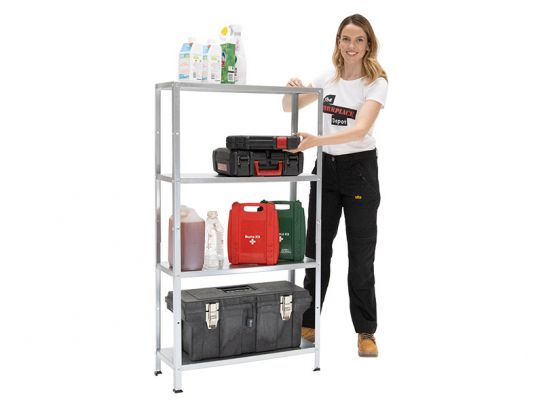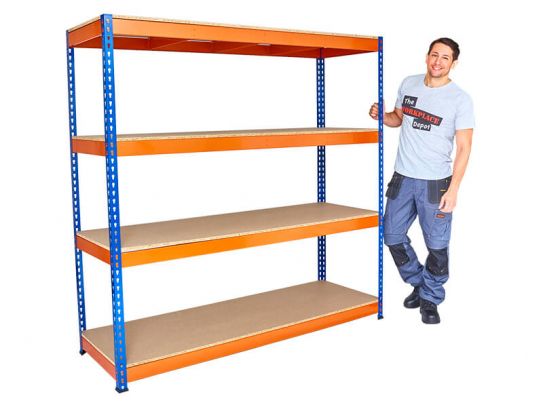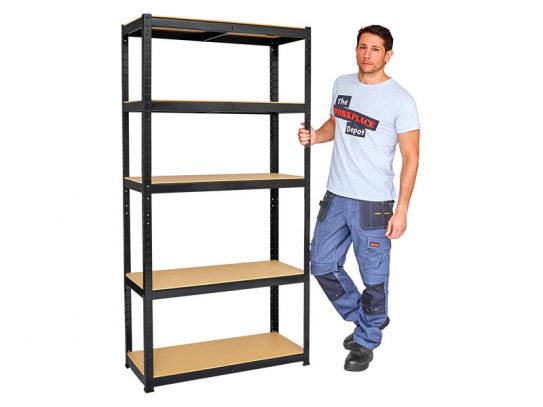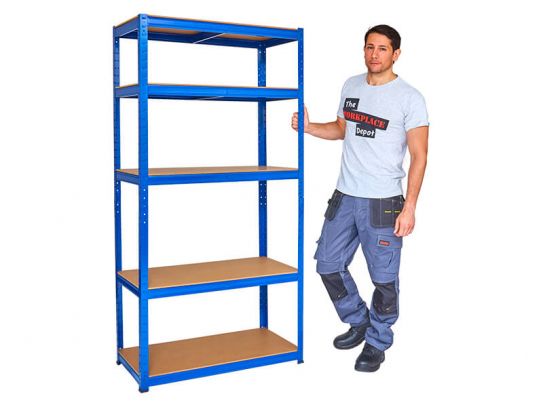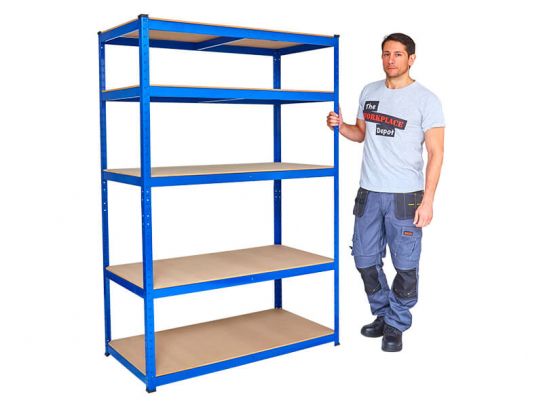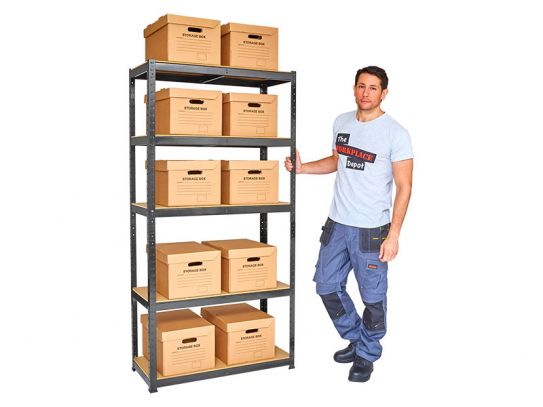Shelving Units
Maximise Your Space, Minimise Your Stress.
Introducing our stylish and versatile shelving units: the perfect solution for cluttered spaces. Our units are designed to help you declutter, organise, and display your items. With a range of sizes, materials, and styles to choose from, you can find the perfect unit to fit your space and your storage needs. Whether you're looking to organise your warehouse, office, or garage, our shelving units are the perfect solution to help you get organised and stay organised. Say goodbye to cluttered spaces and hello to a more efficient workspace. Try one of our shelving units today and start enjoying a more organised and efficient life.
What Is a Shelving Unit?
A shelving unit is a piece of furniture that is used for storing and organising items. It typically consists of a number of shelves, which may be fixed or adjustable, and is used in a variety of settings, including homes, offices, and warehouses. Shelving units can be made from a variety of materials, including wood, metal, and plastic, and are available in a range of sizes and styles to suit different needs and preferences.
What Are Some Common Uses for Shelving Units?
Shelving units are versatile pieces of furniture that can be used in a variety of settings and for a variety of purposes. Some common uses for shelving units include:
- Storing and organising household items, such as books, DVDs, and linens
- Displaying decorative items, such as plants, vases, and figurines
- Organising office supplies, such as paper, pens, and envelopes
- Storing food, dishes, and cooking equipment in a kitchen
- Holding tools, parts, and other equipment in a workshop or garage
- Storing and organising items in a retail store or warehouse
Shelving units can also be used in commercial and industrial settings for a variety of purposes, such as storing and organising inventory, equipment, and supplies.
What Are the Different Types of Shelving Unit?
There are many different types of shelving units available, and the type that is best for you will depend on your specific needs and preferences. Some common types of shelving units include:
- Freestanding shelving units: These are standalone shelving units that can be placed anywhere in a room. They are often made from wood or metal and are available in a range of sizes and styles.
- Wall-mounted shelving units: These are shelving units that are attached to a wall, either with screws or with brackets. They are a good option if you have limited floor space, or if you want to create a custom storage solution.
- Corner shelving units: These are shelving units that are designed to fit into a corner, making them a good option if you have a small space or an awkward layout.
- Adjustable shelving units: These are shelving units that have shelves that can be moved or rearranged to accommodate different types and sizes of items.
- Stackable shelving units: These are shelving units that can be stacked on top of each other to create a customised storage solution.
In addition to these types of shelving units, there are also many other specialised shelving units available for specific purposes, such as shoe racks, kitchen pantries, and garage storage systems.
What Are the Key Features When Choosing a Shelving Unit?
When choosing a shelving unit, there are several key features to consider, including:
- Size: The size of the shelving unit is important, as it needs to be able to fit in the space where you want to put it, and it also needs to be able to hold the items that you want to store on it. Consider the dimensions of the unit, as well as the number of shelves and the weight capacity of each shelf.
- Material: The material that the shelving unit is made from will affect its durability, appearance, and cost. Common materials include wood, metal, and plastic. Wood is a popular choice for its natural look and durability, but it can be expensive. Metal shelving units are strong and sturdy, but they may not have the same aesthetic appeal as wood. Plastic shelving units are lightweight and affordable, but they may not be as durable as other materials.
- Style: Shelving units come in a wide range of styles, from traditional to modern, so you can choose a unit that fits the decor of your space. Consider the overall look and feel of the unit, as well as any additional features, such as doors, drawers, or decorative accents.
In addition to these key features, you should also consider the specific needs and requirements of your space, such as the items that you want to store on the shelving unit and the layout of the room. This will help you choose a shelving unit that is well-suited to your specific needs and preferences.
How Should I Maintain My Shelving Units?
To maintain your shelving unit, you should:
- Keep the unit clean and free of dust and debris. This will help prevent damage to the unit and keep it looking its best. Use a soft, damp cloth to wipe down the shelves and other surfaces, and use a vacuum with a soft brush attachment to remove any dust or debris that has accumulated in hard-to-reach areas.
- Check the unit regularly for signs of damage or wear. This could include loose or sagging shelves, cracked or broken boards, or bent or rusted metal parts. If you notice any damage, repair or replace the affected parts as soon as possible to prevent further damage to the unit.
- Use the unit as intended. Avoid overloading the shelves, as this can cause the unit to become unstable or even collapse. Also, avoid using the unit to store items that are too heavy or bulky, as this could put too much strain on the unit and cause it to become damaged.
- Protect the unit from moisture and extreme temperatures. If the unit is in a damp or humid environment, such as a basement or garage, make sure to use a dehumidifier to reduce moisture levels and prevent damage to the unit. Additionally, avoid placing the unit near sources of heat, such as radiators or fireplaces, as this could cause the unit to warp or become damaged.
By following these tips, you can help maintain your shelving unit and keep it in good condition for many years to come.
Are There Any Environmental or Sustainability Benefits Associated with Using Shelving Units?
Using shelving units can have some environmental and sustainability benefits, depending on the materials that the unit is made from and how it is used. For example:
- Using a shelving unit can help reduce clutter and improve the organisation of a space, which can help save energy and resources. By making it easier to find and access items, a shelving unit can help reduce the need for excessive lighting, heating, and cooling in a space.
- Using a shelving unit can help reduce the need for disposable or single-use storage containers, such as cardboard boxes or plastic bags. This can help reduce waste and prevent pollution, as well as save money and resources.
- Using a shelving unit can help extend the useful life of items. By organising and storing items on a shelving unit, you can help prevent them from becoming lost or damaged, which can prolong their useful life and reduce the need for replacements.
- Using a shelving unit made from sustainable materials can also have environmental benefits. For example, using a unit made from recycled wood or metal can help conserve natural resources, while using a unit made from biodegradable or compostable materials can help reduce waste and pollution.
Overall, using shelving units can be a sustainable and environmentally-friendly option for organising and storing items in a space.
Are There Any EU or UK Standards That Affect Shelving Units?
There are several European Union (EU) and United Kingdom (UK) standards that affect shelving units, depending on the type of unit and its intended use. Some of these standards include:
- The European standard EN 14749, which sets out requirements for freestanding shelving units for domestic and non-domestic use. This standard covers factors such as the strength and stability of the unit, the dimensions and spacing of the shelves, and the labelling and instructions for use.
- The European standard EN 16890, which sets out requirements for wall-mounted shelving units. This standard covers factors such as the strength and stability of the unit, the dimensions and spacing of the shelves, and the methods of attachment to the wall.
- The European standard EN 15512, which sets out requirements for adjustable shelving units. This standard covers factors such as the strength and stability of the unit, the dimensions and spacing of the shelves, and the mechanisms for adjusting the shelves.
- The European standard EN 15620, which sets out requirements for stackable shelving units. This standard covers factors such as the strength and stability of the unit, the dimensions and spacing of the shelves, and the methods of stacking and unstacking the units.
These standards apply to shelving units that are sold within the EU and UK, and manufacturers must ensure that their products meet the requirements of these standards in order to be sold. Additionally, there may be other national or regional standards that apply to shelving units in specific countries or regions.
